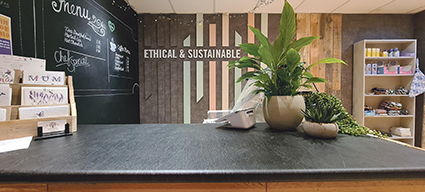Designing sustainable spaces within hotels poses a challenge, both financially and in terms of guest experience, but it is essential if they want to remain a popular booking choice and keep ahead of the competition.
 When it comes to planning refurbishments, hotels want designs with the wow factor but with minimal disruption, so as not to lose any revenue. There is also now the added ‘green’ pressure not to waste FF&E structures despite needing to keep up with trends or dealing with general wear and tear.
When it comes to planning refurbishments, hotels want designs with the wow factor but with minimal disruption, so as not to lose any revenue. There is also now the added ‘green’ pressure not to waste FF&E structures despite needing to keep up with trends or dealing with general wear and tear.
With the mantra of ‘wrap, don’t scrap’, leading architectural films supplier Architextural has the answer, offering the prospect of a whole new look at a fraction of the cost – or waste.
Marketing manager, Lindsay Appleton, says, “With almost a third of landfill waste resulting from the construction and demolition of buildings, reusing existing furniture and fittings is certainly the more environmentally friendly option.
“The use of architectural films allows hotel owners and designers to give what already exists, which may still be structurally sound, a new lease of life.”
Fitted easily by qualified installers, with very little disruption to day-to-day operations, architectural films can mimic the look and feel of all sorts of materials, both natural and synthetic, at a fraction of the usual price.
What’s more, they’re created to be long-lasting and durable, making wrapping the perfect choice for high-traffic areas, such as reception rooms, cafés and bars.
Lindsay says, “Architectural films really are a secret weapon for hotel designers. As well as extending the life of structurally sound surfaces, they can be used as an alternative to real wood, which protects the natural world by recreating the look and feel of wood grain without having to cut down trees.”
But what about plastic?
There is an argument that films and wraps are not environmentally friendly since they are mainly made from PVC. This is what allows for the great flexibility and adhesive nature of the product.
But this negative is far outweighed by the benefits that architectural films and wraps offer hotel owners and designers.
Lindsay adds, “Yes, PVC gets bad press. It is man-made, has a complex, chemical-heavy production process and so is certainly not the greenest product available. It is, however, long-lasting and so when used in high-traffic properties such as hotels, it is far more sustainable. By using them, hoteliers and designers are also doing their bit to reduce waste that would end up in landfill.”
For those that just can’t get past that PVC element, there are also a limited number of non-PVC films on the market, and, as appetite grows, there’ll no doubt be more joining them.
In June last year, Architextural announced a partnership with Decal, introducing its PVC-free All Decor 2d range.
The range includes 15 natural and realistic finishes made from a textured non-PVC architectural film, free of halogen, plasticisers and formaldehyde components, making it ideal for applications where sustainability is key.
The lack of PVC doesn’t lead to any loss in functionality; in common with its PVC counterparts, Decal All Decor 2d is suitable for application onto interior flat and simple curved surfaces such as ceilings, walls, doors and furniture, with guaranteed 10 year minimum durability for interior applications.
Lindsay adds, “While PVC-free options are great, they’re the icing on the cake really. Any project undertaken with architectural films is, by its very nature, sustainable, perfectly encapsulating the reuse and recycle ethos.
“We’ve been talking about the environmental benefits of wrapping, and refurbs with film, for years now and it’s great to see the idea becoming more and more mainstream.”
For more information about Architextural’s market-leading range of architectural films, visit the website at: www.architextural.co.uk

